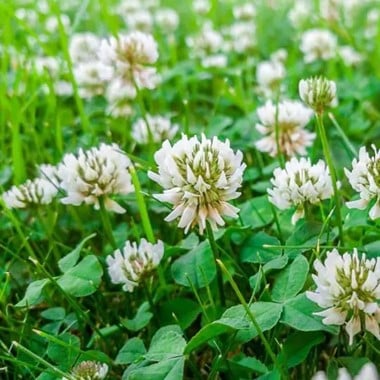Scientific Name: Trifolium repens L.
Description:
It is very prevalent in under-fertilized lawns and grows best in full sun; however, it can also colonize turf areas that receive fertilizer and are partially shaded. White clover produces stolons and can creep into thin turf, forming patches. It grows well in spring, summer, and fall, and is most noticeable when flowering during late spring and early summer. Although some homeowners don’t mind having clover in their lawns, others object to its patchy appearance.
Life Cycle:
White clover belongs to the legume family (Fabaceae) and is classified as a perennial. Plants form patches through branching stems that grow prostrate along the soil surface and root at nodes. Foliage typically dies back in winter and new leaves are produced from crown tissues in spring. Foliage may persist and remain visible during mild winters. White clover produces flowers from spring to fall, with a peak flowering period in late spring to early summer. Flowers eventually produce small seeds with hard coats that can remain dormant in the soil for long periods. Seed germination takes place during cool, moist periods in spring and fall. Like other legumes, white clover exists symbiotically with nitrogen-fixing Rhizobium bacteria which produce nodules on roots and convert atmospheric nitrogen into a plant-available form.
Identification:
White clover stems are smooth to sparsely hairy and grow close to the ground. Leaves are made up of three oval leaflets (trifoliate arrangement) approximately ¼ to ¾ inch in diameter and arise alternately on stems. Margins of leaflets are slightly serrated, with a small indentation at the tip. A white or light green inverted V-shaped pattern often referred to as a watermark, is usually visible on the lower portion of each leaflet. Mature inflorescences are globe-shaped, ½ to ¾ inch in diameter, and contain 20-40 white flowers.
Cultural Control:
White clover is more likely to form large patches in the turf that is not adequately fertilized with nitrogen. Infestations of white clover can be reduced by improving turf density through good establishment procedures and the use of turfgrasses well-adapted to site conditions. This weed is best controlled by herbicides containing dicamba, clopyralid, fluroxypyr, and quinclorac. Products containing combinations of these active ingredients usually provide very good control of white clover. Regrowth of foliage sometimes occurs following spring herbicide applications. Fall applications of herbicides are often the most effective means of controlling white clover.






